Highlights
- Sepsis is a significant global healthcare burden and the leading cause of in-patient mortality.
- Our analysis showed that vitamin C adjunct therapy was linked to a significant decrease in mortality, duration of vasopressor used, and SOFA scores in septic patients.
- There is a further need for a large, randomized control trial to define a clearer role of vitamin C in the care of septic patients.
Abstract
Clinical rationale for study: Despite advancements in critical care, the mortality rate of sepsis remains high, with an overall poor prognosis. There is a complex pathophysiology of a lethal cascade of cytokines and inflammatory proteins underlying sepsis. The use of vitamin C can theoretically suppress the inflammatory cascade but remains a questionable practice due to a lack of conclusive evidence. Aims of the study: To appraise the therapeutic role of vitamin C in sepsis. Materials and methods: A systematic review was conducted on PubMed, Embase, and the Central Cochrane Registry. The study included randomized clinical trials (RCTs) with vitamin C as an intervention arm in the septic patient population. For continuous variables, the difference in means (MD) and for discrete variables, the odds ratio (OR) was used. For effect sizes, a confidence interval of 95% was used. A p-value of less than 0.05 was used for statistical significance. The analysis was performed using a random-effects model irrespective of heterogeneity. Heterogeneity was evaluated using the I2 statistic. Results: 23 studies were included with the total sample size of 2712 patients. In patients treated with vitamin C, there was a statistically significant reduction in the mortality: OR = 0.778 (0.635 to 0.954), p = 0.016; the sequential organ failure assessment score (SOFA): MD = −0.749 (−1.115 to −0.383), p < 0.001; and the duration of vasopressor requirement: MD = −1.034 days (−1.622 to −0.445), p = 0.001. No significant difference was found in the hospital or ICU length of stay. Conclusions and clinical implications: Vitamin C treatment regimens were associated with reduced mortality, SOFA score, and vasopressor requirement compared to the control in sepsis. Given its low cost and minimal adverse effects, we strongly encourage further large, randomized trials to establish vitamin C as a standard of care in sepsis management.
1. Introduction
Sepsis is a syndrome characterized by a host’s amplified dysregulated immune response to an underlying infection, leading to multi-organ malfunction. Despite advanced antimicrobials and therapeutics, sepsis has been linked with high mortality and morbidity []. Endotoxins such as lipopolysaccharide (LPS component of the cell membranes of Gram-negative bacteria) and other pathogen products can provoke the macrophages to secrete proinflammatory cytokines. This overwhelming immune response from the cytokines, including interleukin-6 (IL-6), interleukin-8 (IL-8), interleukin-1b (IL-1b), macrophage inflammatory protein-1b, and tumor necrosis factor (TNF-a) leads to sequelae of sepsis via capillary leakage and organ failure [,].
Globally and nationally, sepsis carries a major burden in morbidity and mortality on the health care system [,]. For instance, in 2017, approximately 11 million patients died due to sepsis. Fortunately, the incidence and mortality related to sepsis have decreased. In 1990, approximately 60.2 million sepsis cases were reported compared to 48.9 million cases in 2017. In the United States, sepsis is still the most common cause of death in hospitalized patients. Additionally, sepsis costs the health care system up to 24 billion dollars [].
Ascorbic acid, more commonly known as vitamin C, is a vital trace element for the human body. Vitamin C is one of the most efficacious water-soluble antioxidants. The human body cannot form vitamin C, an essential nutritional element, and must be supplemented nutritionally. The role of vitamin C in treating multiple diseases has been significant due to its potent antioxidative properties []. The low cost of vitamin C, easy availability, and relatively safe side effect profile make it an attractive prospect as an adjunct to sepsis management.
Clinical Rationale for the Study
Multiple trials have been conducted showing the effectiveness of vitamin C in patients needing intensive care in combination with other drugs or alone. Multiple meta-analyses have reported variable outcomes with conflicting results. We performed this meta-analysis to pool the data from all the previous prospective, randomized control trials to increase the sample size and statistical power to evaluate the role of vitamin C in sepsis.
2. Materials and Methods
The study was performed according to the Preferred Reporting Items for Systematic Reviews and Meta-Analyses (PRISMA) guidelines.
2.1. Eligibility Criteria
The studies that were included:
- were RCTs with supraphysiologic doses of vitamin C as an intervention in septic patients with the standard of care as the control arm.
- had patients aged > 18 years.
- were available in the English language regardless of date or status of publications.
Studies that did not meet the above criteria were excluded.
2.2. Information Sources
The Central Cochrane Registry of clinical trials, Embase, and the PubMed database were used to search relevant articles. A MeSH search with keywords was performed in PubMed, and the PICO search tool was used to search Embase. The MeSH terms included “vitamin C” or “ascorbic” or “ascorbate” and “sepsis” or “septic” or “shock.” All the search terms were exploded without any limitations. The included articles were studied to identify any missing studies. The deadline for publication was set as 31 January 2022.
2.3. Trial Selection and Evaluation
Three authors independently and objectively reviewed all studies and excluded unqualifying articles. The risk of bias for the selected studies was calculated using the Cochrane collaborative tool and categorized into low, uncertain, and high.
The quality of evidence was graded using the GRADE system []. Each outcome was rated for quality, reducing the level of evidence for risk of bias, inconsistency, indirectness, and imprecision.
2.4. Data Extraction
Information was obtained using a pre-specified extraction table. Information was retrieved from the published trials and their tables/appendices, and a second author reviewed the information collected to ensure accuracy. The extracted data included the number of patients, mortality, sequential organ failure assessment score (SOFA) score, hospital length of stay, intensive care unit (ICU) length of stay, and days on pressors.
The primary outcome assessed was short-term mortality, and other outcomes included change in SOFA score, ICU length of stay, duration of vasopressor requirement, and hospital length of stay.
2.5. Statistical Analysis
The meta-analysis was performed using the Comprehensive Meta-analysis Software Version 3 (Biostat USA). We calculated the mean difference in continuous variables for treatment effect measurement while the odds ratio was calculated for discrete variables. Where medians and interquartile ranges were reported, they were assessed for skewness and whether the data were similar to a normal distribution, and the mean and standard deviation were imputed [,,]. Standard errors were calculated using a 95% confidence interval, and a p-value of 0.05 was used to determine statistical significance. The analysis was performed using a random-effects model for consistency in analysis irrespective of heterogeneity. Heterogeneity was evaluated using the I2 statistic; heterogeneity less than 40 was considered low, 40–60 moderate, and above 60 as high [].
3. Results
3.1. Literature Search
A total of 2176 articles were identified in the initial search. After the removal of duplicates, 1930 articles were filtered. The first screening excluded 1858 articles. Full texts of 72 were analyzed. Nine articles were excluded due to being retrospective studies; ten did not have a relevant patient population (burn, etc.), fourteen were review articles, fifteen did not have a relevant intervention, and data reports from one study were not retrieved. Twenty-three randomized control trials were included, with a total of 2712 patients (Figure 1). The main characteristics are given in Table 1.
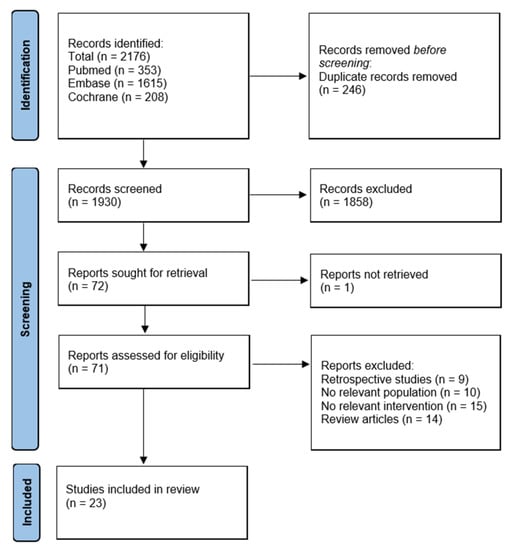
Figure 1.
Prisma Diagram.

Table 1.
Baseline characteristics of included studies.
3.2. Risk of Bias
Allocation: Most studies provided details about the methodology of randomization, except one study [].
Blinding: Most trials were double-blind, except for open-label studies [,].
Incomplete data outcomes: 20 studies were considered a low risk for incomplete data, and 3 were deemed an unclear risk [,,].
Selective reporting: 2 studies were deemed an unclear risk for selective reporting [,], and one study did not provide reasons for excluding individuals from the analysis and was deemed at a high risk for bias [].
The results of the risk of bias are shown in Figure 2 and Figure 3. Overall, most of the information obtained from the studies was deemed to have a low to unclear risk of bias.
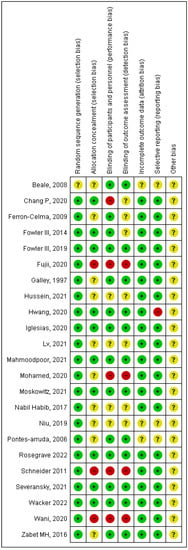
Figure 2.
Summary of bias.
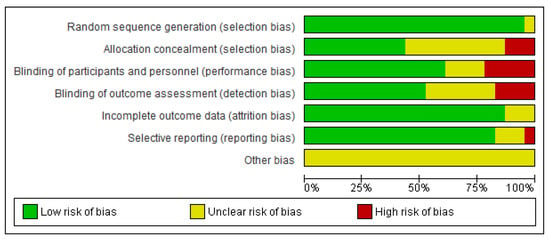
Figure 3.
Summary of bias.
3.3. Publication Bias
The risk of publication bias was assessed using a funnel plot for mortality. No evidence of significant publication bias was detected (Figure 4).
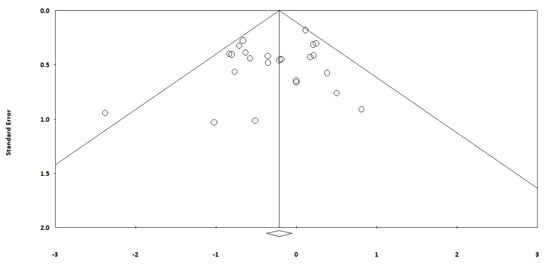
Figure 4.
Funnel plot for publication bias (Mortality).
3.4. Results of Quantitative Analysis
3.4.1. Mortality
Overall
A total of 23 studies reported mortality with vitamin-C-containing therapies. Their use was associated with a statistically significant reduction in mortality with OR = 0.778 (0.635 to 0.954), p = 0.016, and I2 = 25.688 (low heterogeneity, low certainty of evidence) (Figure 5).
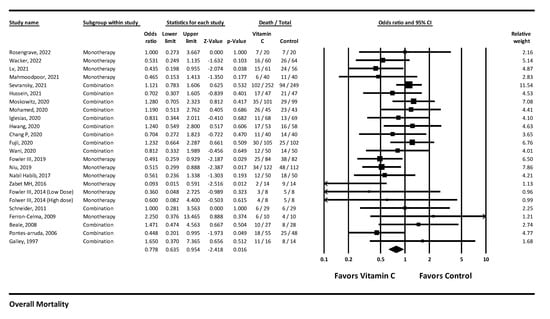
Figure 5.
Overall mortality.
Intravenous Dosing
Twenty studies reported mortality with intravenous regimens containing vitamin C. Their use was associated with a statistically significant reduction in mortality; OR = 0.780 (628 to 0.968), p = 0.024, and I2 = 27.690 (low heterogeneity, low certainty of evidence).
Enteral Dosing
Three studies reported mortality with enteral regimens containing vitamin C. Their use was not associated with a statistically significant change in mortality; OR = 0.782 (0.367 to 1.665), p = 0.524, and I2 = 36.416 (low heterogeneity, very low certainty of evidence).
3.4.2. SOFA Score
Eleven studies reported a change in SOFA score with vitamin-C-containing treatment regimens. Their use was associated with a statistically significant reduction in SOFA score with MD = −0.749 (−1.115 to −0.383), p < 0.001, and I2 = 25.862 (low heterogeneity, low certainty of evidence). (Figure 6).
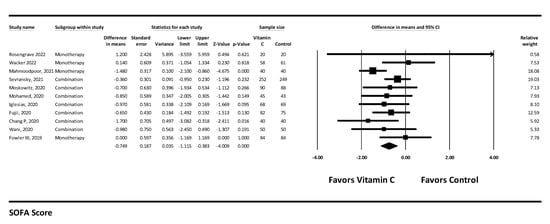
Figure 6.
SOFA score.
3.4.3. Hospital Length of Stay
Six studies reported hospital length of stay with vitamin-C-containing treatment regimens. Their use was not associated with a significant reduction in hospital stay; MD = 1.321 (−1.073 to 3.714), p = 0.279, and I2 = 20.95 (low heterogeneity, very low certainty of evidence).
3.4.4. ICU Length of Stay
Nine studies reported ICU length of stay with vitamin-C-containing treatment regimens. Their use was not associated with a significant decrease in ICU length of stay; MD = −0.804 days (−2.374 to 0.766), p = 0.315, I2 = 52.347 (moderate heterogeneity, very low certainty of evidence).
3.4.5. Duration of Vasopressors Use
Twelve studies reported the duration of vasopressor support in patients with vitamin C therapy. Their use was associated with statistically significant reduced time on vasopressors; MD = −1.034 (−1.622 to −0.445), p = 0.001, I2 = 88.966 (high heterogeneity, very low certainty of evidence).
3.5. Subgroup Analysis
3.5.1. Monotherapy
Treatment regimens with vitamin C monotherapy were associated with a statistically significant reduction in mortality: OR = 0.515 (0.390 to 0.680), p < 0.001, and I2 = 0 (low heterogeneity, moderate certainty of evidence); a reduction in ICU length of stay: MD = −2.551 days (−4.577 to −0.525), p = 0.014, and I2 = 37.983 (low heterogeneity); and a reduced time on vasopressors: MD = −1.180 days (−2.021 to −0.240), p = 0.006, and I2 = 92.664 (high heterogeneity). No significant change in the length of hospital stay or SOFA scores was reported.
3.5.2. Combination Therapy
In some trials, vitamin C was used as a combination therapy with hydrocortisone and thiamine as an intravenous HAT regimen or enteral feed formula containing vitamin C. These combination regimens were associated with a statistically significant reduction in SOFA score: MD = −0.690 (−1.056 to −0.324), p < 0.001, and I2 = 0 (low heterogeneity); and reduction in duration of vasopressor use: MD = −0.933 days (−1.341 to −0.525), p < 0.001, and I2 = 17.709 (low heterogeneity). There was no statistical difference observed in mortality, ICU, or hospital length of stay.
3.6. Sensitivity Analysis
A sensitivity analysis for mortality was performed with the removal of studies identified with a possible high risk of bias, and no significant change in the results was noted: OR = 0.696 (0.538 to 0.900), p = 0.006 [,,,]. Similarly, studies with imputed standard deviations were excluded from SOFA score studies, but no significant change in the results was noted: MD = −1.062 (−1.458 to −0.666), p < 0.001 [,,].
3.7. Summary of Results
Overall, treatment regimens containing vitamin C were associated with a statistically significant reduction in mortality, SOFA scores, and duration of vasopressor requirement compared to the control group. No statistically significant difference was found in ICU or hospital length of stay. A summary of the primary outcome (mortality) with the subgroup analysis results is shown in Table 2. A summary of the secondary outcomes is shown in Table 3.

Table 2.
Summary of results for the primary outcome (Mortality).

Table 3.
Summary of results (secondary outcomes).
4. Discussion
This meta-analysis included only 23 randomized control trials, while retrospective studies were excluded from the analysis. In 20 of these studies, the studied group received intravenous treatment regimens containing vitamin C, while the other 3 studies included study groups that received enteral regimens containing vitamin C. Interventions in some of these selected studies included vitamin C alone (monotherapy group) and the standard of care. In other studies, vitamin C was combined with other treatments, including thiamine and hydrocortisone (combination therapy group). Interestingly, our results revealed that patients treated with the vitamin C had significantly improved outcomes across various measures compared with the standard of care, most importantly mortality: OR = 0.778 (0.635 to 0.954), p = 0.016. The exact physiological mechanism by which vitamin C exerts these effects is still not fully understood.
The role of free radicals and reactive oxygen species (ROS) has long been a subject of interest in explaining physiology and disease pathology. Halliwell et al. explored the role of free radicals and ROS in many medical arenas, including cancers and neurodegenerative diseases []. Ascorbic acid provides an electron to another molecule, after which it transforms into an ascorbyl radical, which is the oxidized form of ascorbic acid and a relatively stable free radical []. Ascorbic acid in sepsis has specifically gained more scientific attention in the past years. Outcomes including 28-day mortality, ICU and hospital length of stay, vasopressor requirements, changes in the SOFA score, and others were studied in various articles [,,].
Ascorbic acid in septic patients reportedly decreases inflammatory markers (c-reactive protein and procalcitonin) []. Vitamin C possibly inhibits the TNF-a-induced phosphorylation of inhibitory kappa-B kinase (IkB kinase), suppressing NF-kB and histamine levels in the blood [,]. It may also suppress high mobility group box-1 (HMGB-1) release from the LPS-activated macrophages, leading to improved survival and reduced (HMGB-1) levels in the septic host [,,,].
High concentrations of vitamin C in macrophages, leukocytes, and lymphocytes enhance their phagocytic potential, oxidative killing, and promoting lymphocyte proliferation. The neutrophil extracellular trap (NET) is a novel mechanism deployed by the host cells to kill pathogens. Nevertheless, a disproportionate NET during sepsis can harm host organs, and vitamin C is shown to alter and mediate the NET formation during sepsis [,].
Studies have shown that adding vitamin C into a medium containing lymphocytes from the peripheral circulation reduces the lipopolysaccharide (LPS)-induced production of the proinflammatory cytokines, specifically TNF-α and IFN-γ [], and increases the production of the anti-inflammatory cytokine IL-1 []. Similarly, other studies conducted in vitro show that mixing ascorbic acid with monocytes isolated from the peripheral circulation of patients with underlying pneumonia resulted in the diminished production of the proinflammatory cytokines TNF-α and IL-6 [] and the augmentation of IFN levels [,,]. Therefore, there is evidence that ascorbic acid influences cytokine regulation, including the modulation in the cytokine levels deranged in sepsis.
Several meta-analyses have analyzed the role of vitamin C in multiple diseases [,]; some studies have focused on critically ill patients [,], including heterogeneous diseases and patient populations in the analysis. In contrast, others have analyzed the role of vitamin C in specific patient populations, such as COVID-19 and respiratory tract infections [,]. Several studies have addressed the role of hydrocortisone, ascorbic acid, and thiamine in sepsis [,,,,], while others have considered vitamin-C-containing regimens [,,]. Some previous studies, which included all regimens containing vitamin C, have indicated a trend toward lower short-term mortality [,]. Studies including combination therapies have yielded heterogeneous results ranging from no difference in mortality [] to significant changes in mortality []. Different inclusion parameters and study populations partially explain the heterogeneity of outcomes in different reviews. Based on conflicting data from multiple trials, “Surviving sepsis guidelines” recommended against routine use of intravenous vitamin C based on 7 RCTs included in their analysis. More studies with increasing data have been published since the publication of the guidelines.
Most of the previous meta-analyses have reported an improvement in SOFA scores with vitamin C use [,,]. Since their publication, other trials have been performed. Our analysis adds to the growing evidence of the positive impact of vitamin C use in the septic patient population. Our study’s major strength is that it only included randomized trials and excluded all observational studies in order to generate the highest strength of evidence possible. We included all the latest literature on the topic to the best of our efforts. Our results demonstrating a reduction in mortality and SOFA score improvement align with most previous studies on the topic. In addition to the amelioration observed in the clinical status and significant improvement in patient care, this remains an important finding because intravenous vitamin C is readily available, very affordable, and has very limited secondary side effects.
This study, as a meta-analysis, remains a retrospective review and generates various biases. Heterogeneity remains a significant challenge, given the inclusion of studies with different patient populations in different stages of diseases. Secondly, there is no universally accepted dose of vitamin C, which could be defined as a “high dose,” and little to no data exist to guide frequency, dosing, and route of administration. Some of the studies utilized an enteral route of drug administration, which in the septic population suffers from erratic absorption and significant drug–drug interactions. Most studies did not report complete patient data, age groups, and reasons for mortality, which also weakens the overall certainty of the evidence. Many studies reported medians for reporting their outcomes, which showed significant deviation from the normal distribution and had to be excluded from the analysis, thereby decreasing the population pool [,,,,]. Furthermore, the combination of intervention drugs with other drugs, differences in ICU protocols, and hospital policies also contribute to the high heterogeneity and low certainty of the outcomes.
Overall, we made our greatest attempt to include all relevant published studies and extract data for analysis. There are several ongoing trials on this topic, and soon, we might have more definite answers regarding the efficacy, dosing, route, and timing of the administration of vitamin C in the septic patient population [,,].
Clinical Implications and Future Directions
Based on this pooled evidence, we advocate using vitamin C as an adjunct to the standard of care for sepsis management, given the postulated reduction in mortality, low cost, and relatively safe adverse effect profile. There remains a need for a large, multi-center, randomized control trial with enough power to better understand and answer questions regarding the utility, timing of administration, route of delivery, and dosage of vitamin C in sepsis.
Author Contributions
Manuscript was written by A.K., M.M., S.B.A.S., A.J. (Abdullah Jahangir), A.J. (Ahmad Jahangir), L.D., M.R.K.N., A.S. and A.I. Data extraction and analysis by A.J. (Ahmad Jahangir), A.I., A.K., A.M. and Z.Z. Proofreading and literature review by A.J. (Abdullah Jahangir), D.M., F.S.S., W.S., S.S., D.E. and M.C. All authors have read and agreed to the published version of the manuscript.
Funding
This publication was prepared without any external source of funding.
Institutional Review Board Statement
Not applicable.
Informed Consent Statement
Ethical approval was not necessary for the preparation of this article.
Data Availability Statement
Not applicable.
Conflicts of Interest
No conflict of interest are reported for all the authors.
References
- Singer, M.; Deutschman, C.S.; Seymour, C.W.; Shankar-Hari, M.; Annane, D.; Bauer, M.; Bellomo, R.; Bernard, G.R.; Chiche, J.-D.; Coopersmith, C.M.; et al. The Third International Consensus Definitions for Sepsis and Septic Shock (Sepsis-3). JAMA 2016, 315, 801–810. [Google Scholar] [CrossRef]
- Tracey, K.J.; Fong, Y.; Hesse, D.G.; Manogue, K.R.; Lee, A.T.; Kuo, G.C.; Lowry, S.F.; Cerami, A. Anti-cachectin/TNF monoclonal antibodies prevent septic shock during lethal bacteraemia. Nature 1987, 330, 662–664. [Google Scholar] [CrossRef] [PubMed]
- Ulloa, L.; Tracey, K.J. The “cytokine profile”: A code for sepsis. Trends Mol. Med. 2005, 11, 56–63. [Google Scholar] [CrossRef]
- Adhikari, N.K.; Fowler, R.A.; Bhagwanjee, S.; Rubenfeld, G.D. Critical care and the global burden of critical illness in adults. Lancet 2010, 376, 1339–1346. [Google Scholar] [CrossRef]
- Luhr, R.; Cao, Y.; Söderquist, B.; Cajander, S. Trends in sepsis mortality over time in randomised sepsis trials: A systematic literature review and meta-analysis of mortality in the control arm, 2002–2016. Crit. Care 2019, 23, 241. [Google Scholar] [CrossRef] [Green Version]
- Rudd, K.E.; Johnson, S.C.; Agesa, K.M.; Shackelford, K.A.; Tsoi, D.; Kievlan, D.R.; Colombara, D.V.; Ikuta, K.S.; Kissoon, N.; Finfer, S.; et al. Global, regional, and national sepsis incidence and mortality, 1990–2017: Analysis for the Global Burden of Disease Study. Lancet 2020, 395, 200–211. [Google Scholar] [CrossRef] [Green Version]
- Liu, Y.; Liu, C.; Li, J. Comparison of Vitamin C and its derivative antioxidant activity: Evaluated by using density functional theory. ACS Omega 2020, 5, 25467–25475. [Google Scholar] [CrossRef] [PubMed]
- Guyatt, G.; Oxman, A.D.; Akl, E.A.; Kunz, R.; Vist, G.; Brozek, J.; Norris, S.; Falck-Ytter, Y.; Glasziou, P.; DeBeer, H.; et al. GRADE guidelines: 1. Introduction-GRADE evidence profiles and summary of findings tables. J. Clin. Epidemiol. 2011, 64, 383–394. [Google Scholar] [CrossRef]
- Luo, D.; Wan, X.; Liu, J.; Tong, T. Optimally estimating the sample mean from the sample size, median, mid-range, and/or mid-quartile range. Stat. Methods Med. Res. 2018, 27, 1785–1805. [Google Scholar] [CrossRef] [Green Version]
- Wan, X.; Wang, W.; Liu, J.; Tong, T. Estimating the sample mean and standard deviation from the sample size, median, range and/or interquartile range. BMC Med. Res. Methodol. 2014, 14, 135. [Google Scholar] [CrossRef] [Green Version]
- Shi, J.; Luo, D.; Wan, X.; Liu, Y.; Liu, J.; Bian, Z.; Tong, T. Detecting the skewness of data from the sample size and the five-number summary. arXiv 2020, arXiv:2010.05749. [Google Scholar]
- Rosengrave, P.; Spencer, E.; Williman, J.; Mehrtens, J.; Morgan, S.; Doyle, T.; Van Der Heyden, K.; Morris, A.; Shaw, G.; Carr, A.C. Intravenous vitamin C administration to patients with septic shock: A pilot randomised controlled trial. Crit. Care 2022, 26, 26. [Google Scholar] [CrossRef] [PubMed]
- Wacker, D.A.; Burton, S.L.; Berger, J.P.; Hegg, A.J.; Heisdorffer, J.; Wang, Q.; Medcraft, E.J.; Reilkoff, R.A. Evaluating Vitamin C in Septic Shock: A Randomized Controlled Trial of Vitamin C Monotherapy. Crit. Care Med. 2021, 50, e458–e467. [Google Scholar] [CrossRef] [PubMed]
- Lv, S.J.; Zhang, G.H.; Xia, J.M.; Yu, H.; Zhao, F. Early use of high-dose vitamin C is beneficial in treatment of sepsis. Ir. J. Med. Sci. 2021, 190, 1183–1188. [Google Scholar] [CrossRef] [PubMed]
- Mahmoodpoor, A.; Shadvar, K.; Sanaie, S.; Hadipoor, M.R.; Pourmoghaddam, M.A.; Saghaleini, S.H. Effect of Vitamin C on mortality of critically ill patients with severe pneumonia in intensive care unit: A preliminary study. BMC Infect. Dis. 2021, 21, 616. [Google Scholar] [CrossRef] [PubMed]
- Syed, A.A.; Knowlson, S.; Sculthorpe, R.; Farthing, D.; DeWilde, C.; Farthing, C.A.; Larus, T.L.; Martin, E.; Brophy, D.F.; Gupta, S.; et al. Phase I safety trial of intravenous ascorbic acid in patients with severe sepsis. J. Transl. Med. 2014, 12, 32. [Google Scholar]
- Truwit, J.D.; Hite, R.D.; Morris, P.E.; DeWilde, C.; Priday, A.; Fisher, B.; Thacker, L.R.; Natarajan, R.; Brophy, D.F.; Sculthorpe, R.; et al. Effect of Vitamin C Infusion on Organ Failure and Biomarkers of Inflammation and Vascular Injury in Patients with Sepsis and Severe Acute Respiratory Failure: The CITRIS-ALI Randomized Clinical Trial. JAMA 2019, 322, 1261–1270. [Google Scholar]
- Zabet, M.H.; Mohammadi, M.; Ramezani, M.; Khalili, H. Effect of high-dose Ascorbic acid on vasopressor’s requirement in septic shock. J. Res. Pharm. Pract. 2016, 5, 94–100. [Google Scholar] [PubMed]
- Nabil Habib, T.; Ahmed, I. Early adjuvant intravenous vitamin C treatment in septic shock may resolve the vasopressor dependence. Int. J. Microbiol. Adv. Immunol. 2017, 5, 77–81. [Google Scholar]
- Ferrón-Celma, I.; Mansilla, A.; Hassan, L.; Garcia-Navarro, A.; Comino, A.M.; Bueno, P.; Ferrón, J.A. Effect of vitamin C administration on neutrophil apoptosis in septic patients after abdominal surgery. J. Surg. Res. 2009, 153, 224–230. [Google Scholar] [CrossRef] [PubMed]
- Galley, H.F.; Howdle, P.D.; Walker, B.E.; Webster, N.R. The effects of intravenous antioxidants in patients with septic shock. Free Radic. Biol. Med. 1997, 23, 768–774. [Google Scholar] [CrossRef]
- Hussein, A.A.; Sabry, N.A.; Abdalla, M.S.; Farid, S.F. A prospective, randomised clinical study comparing triple therapy regimen to hydrocortisone monotherapy in reducing mortality in septic shock patients. Int. J. Clin. Pract. 2021, 75, e14376. [Google Scholar] [CrossRef]
- Wani, S.J.; Mufti, S.A.; Jan, R.A.; Shah, S.U.; Qadri, S.M.; Khan, U.H.; Bagdadi, F.; Mehfooz, N.; Koul, P.A. Combination of vitamin C, thiamine and hydrocortisone added to standard treatment in the management of sepsis: Results from an open label randomised controlled clinical trial and a review of the literature. Infect. Dis. 2020, 52, 271–278. [Google Scholar] [CrossRef] [PubMed]
- Sevransky, J.E.; Rothman, R.E.; Hager, D.N.; Bernard, G.R.; Brown, S.M.; Buchman, T.G.; Busse, L.W.; Coopersmith, C.M.; DeWilde, C.; Ely, E.W.; et al. Effect of Vitamin C, Thiamine, and Hydrocortisone on Ventilator- and Vasopressor-Free Days in Patients with Sepsis: The VICTAS Randomized Clinical Trial. JAMA 2021, 325, 742–750. [Google Scholar] [CrossRef]
- Moskowitz, A.; Huang, D.T.; Hou, P.C.; Gong, J.; Doshi, P.B.; Grossestreuer, A.V.; Andersen, L.W.; Ngo, L.; Sherwin, R.L.; Berg, K.M.; et al. Effect of Ascorbic Acid, Corticosteroids, and Thiamine on Organ Injury in Septic Shock: The ACTS Randomized Clinical Trial. JAMA 2020, 324, 642–650. [Google Scholar] [CrossRef] [PubMed]
- Menon, V.; Mohamed, Z.U.; Prasannan, P.; Moni, M.; Edathadathil, F.; Prasanna, P.; Menon, A.; Nair, S.; Greeshma, C.; Sathyapalan, D.T.; et al. Vitamin C Therapy for Routine Care in Septic Shock (ViCTOR) Trial: Effect of Intravenous Vitamin C, Thiamine, and Hydrocortisone Administration on Inpatient Mortality among Patients with Septic Shock. Indian J. Crit. Care Med. 2020, 24, 653–661. [Google Scholar] [CrossRef] [PubMed]
- Iglesias, J.; Vassallo, A.V.; Patel, V.V.; Sullivan, J.B.; Cavanaugh, J.; Elbaga, Y. Outcomes of Metabolic Resuscitation Using Ascorbic Acid, Thiamine, and Glucocorticoids in the Early Treatment of Sepsis: The ORANGES Trial. Chest 2020, 158, 164–173. [Google Scholar] [CrossRef] [PubMed]
- Hwang, S.Y.; Ryoo, S.M.; Park, J.E.; Jo, Y.H.; Jang, D.H.; Suh, G.J.; Kim, T.; Kim, Y.J.; Kim, S.; Cho, H.; et al. Combination therapy of vitamin C and thiamine for septic shock: A multi-centre, double-blinded randomized, controlled study. Intensive Care Med. 2020, 46, 2015–2025. [Google Scholar] [CrossRef]
- Fujii, T.; Luethi, N.; Young, P.J.; Frei, D.R.; Eastwood, G.M.; French, C.J.; Deane, A.M.; Shehabi, Y.; Hajjar, L.A.; Oliveira, G.; et al. Effect of Vitamin C, Hydrocortisone, and Thiamine vs Hydrocortisone Alone on Time Alive and Free of Vasopressor Support Among Patients with Septic Shock: The VITAMINS Randomized Clinical Trial. JAMA 2020, 323, 423–431. [Google Scholar] [CrossRef] [PubMed]
- Chang, P.; Liao, Y.; Guan, J.; Guo, Y.; Zhao, M.; Hu, J.; Zhou, J.; Wang, H.; Cen, Z.; Tang, Y.; et al. Combined Treatment with Hydrocortisone, Vitamin C, and Thiamine for Sepsis and Septic Shock: A Randomized Controlled Trial. Chest 2020, 158, 174–182. [Google Scholar] [CrossRef] [PubMed]
- Niu, J.J.; Qin, B.Y.; Yang, K.L.; Fan, Q.B.; Liu, W.Q.; Wang, C.Z. Effect of early exogenous vitamin C supplementation on prognosis of sepsis patients. China J. Mod. Med. 2019, 29, 65–69. [Google Scholar]
- Beale, R.J.; Sherry, T.; Lei, K.; Campbell-Stephen, L.; McCook, J.; Smith, J.; Venetz, W.; Alteheld, B.; Stehle, P.; Schneider, H. Early enteral supplementation with key pharmaconutrients improves Sequential Organ Failure Assessment score in critically ill patients with sepsis: Outcome of a randomized, controlled, double-blind trial. Crit. Care Med. 2008, 36, 131–144. [Google Scholar] [CrossRef]
- Pontes-Arruda, A.; Aragão, A.M.; Albuquerque, J.D. Effects of enteral feeding with eicosapentaenoic acid, gamma-linolenic acid, and antioxidants in mechanically ventilated patients with severe sepsis and septic shock. Crit. Care Med. 2006, 34, 2325–2333. [Google Scholar] [CrossRef] [PubMed] [Green Version]
- Schneider, A.; Markowski, A.; Momma, M.; Seipt, C.; Luettig, B.; Hadem, J.; Wilhelmi, M.; Manns, M.P.; Wedemeyer, J. Tolerability and efficacy of a low-volume enteral supplement containing key nutrients in the critically ill. Clin. Nutr. 2011, 30, 599–603. [Google Scholar] [CrossRef] [PubMed]
- Halliwell, B. Free radicals and antioxidants: Updating a personal view. Nutr. Rev. 2012, 70, 257–265. [Google Scholar] [CrossRef] [PubMed]
- Michels, A.J.; Hagen, T.M.; Frei, B. Human genetic variation influences vitamin C homeostasis by altering vitamin C transport and antioxidant enzyme function. Annu. Rev. Nutr. 2013, 33, 45–70. [Google Scholar] [CrossRef] [PubMed] [Green Version]
- Marik, P.E. Vitamin C for the treatment of sepsis: The scientific rationale. Pharmacol. Ther. 2018, 189, 63–70. [Google Scholar] [CrossRef]
- Cárcamo, J.M.; Pedraza, A.; Bórquez-Ojeda, O.; Golde, D.W. Vitamin C suppresses TNF alpha-induced NF kappa B activation by inhibiting I kappa B alpha phosphorylation. Biochemistry 2002, 41, 12995–13002. [Google Scholar] [CrossRef] [PubMed]
- Wang, H.; Yang, H.; Czura, C.J.; Sama, A.E.; Tracey, K.J. HMGB1 as a late mediator of lethal systemic inflammation. Am. J. Respir. Crit. Care Med. 2001, 164, 1768–1773. [Google Scholar] [CrossRef] [PubMed]
- Mohammed, B.M.; Fisher, B.J.; Kraskauskas, D.; Farkas, D.; Brophy, D.F.; Fowler, A.A.; Natarajan, R. Vitamin C: A novel regulator of neutrophil extracellular trap formation. Nutrients 2013, 5, 3131–3151. [Google Scholar] [CrossRef] [Green Version]
- Hemilä, H. Vitamin C and Infections. Nutrients 2017, 9, 339. [Google Scholar] [CrossRef] [Green Version]
- Molina, N.; Morandi, A.C.; Bolin, A.P.; Otton, R. Comparative effect of fucoxanthin and vitamin C on oxidative and functional parameters of human lymphocytes. Int. Immunopharmacol. 2014, 22, 41–50. [Google Scholar] [CrossRef] [PubMed]
- Chen, Y.; Luo, G.; Yuan, J.; Wang, Y.; Yang, X.; Wang, X.; Li, G.; Liu, Z.; Zhong, N. Vitamin C mitigates oxidative stress and tumor necrosis factor-alpha in severe community-acquired pneumonia and LPS-induced macrophages. Mediat. Inflamm. 2014, 2014, 426740. [Google Scholar] [CrossRef] [Green Version]
- Dahl, H.; Degré, M. The effect of ascorbic acid on production of human interferon and the antiviral activity in vitro. Acta. Pathol. Microbiol. Scand. B 1976, 84b, 280–284. [Google Scholar] [CrossRef]
- Karpińska, T.; Kawecki, Z.; Kandefer-Szerszeń, M. The influence of ultraviolet irradiation, L-ascorbic acid and calcium chloride on the induction of interferon in human embryo fibroblasts. Arch. Immunol. Ther. Exp. 1982, 30, 33–37. [Google Scholar]
- Siegel, B.V. Enhancement of interferon production by poly(rI)-poly(rC) in mouse cell cultures by ascorbic acid. Nature 1975, 254, 531–532. [Google Scholar] [CrossRef] [PubMed]
- Scholz, S.S.; Borgstedt, R.; Ebeling, N.; Menzel, L.C.; Jansen, G.; Rehberg, S. Mortality in septic patients treated with vitamin C: A systematic meta-analysis. Crit. Care 2021, 25, 17. [Google Scholar] [CrossRef] [PubMed]
- Sato, R.; Hasegawa, D.; Prasitlumkum, N.; Ueoka, M.; Nishida, K.; Takahashi, K.; Nasu, M.; Dugar, S. Effect of IV High-Dose Vitamin C on Mortality in Patients with Sepsis: A Systematic Review and Meta-Analysis of Randomized Controlled Trials. Crit. Care Med. 2021, 49, 2121–2130. [Google Scholar] [CrossRef] [PubMed]
- Patel, J.J.; Ortiz-Reyes, A.; Dhaliwal, R.; Clarke, J.; Hill, A.; Stoppe, C.; Lee, Z.Y.; Heyland, D.K. IV Vitamin C in Critically Ill Patients: A Systematic Review and Meta-Analysis. Crit. Care Med. 2022, 50, e304–e312. [Google Scholar] [CrossRef] [PubMed]
- Du, X.; Yang, C.; Yu, X. Effect of vitamin C on prognosis of critically ill patients: A Meta-analysis. Zhonghua Wei Zhong Bing Ji Jiu Yi Xue 2019, 31, 942–948. [Google Scholar] [PubMed]
- Ao, G.; Li, J.; Yuan, Y.; Wang, Y.; Nasr, B.; Bao, M.; Gao, M.; Qi, X. Intravenous vitamin C use and risk of severity and mortality in COVID-19: A systematic review and meta-analysis. Nutr. Clin. Pract. 2022, 37, 274–281. [Google Scholar] [CrossRef] [PubMed]
- Keya, T.A.; Leela, A.; Fernandez, K.; Habib, N.; Rashid, M. Effect of Vitamin C Supplements on Respiratory Tract Infections: A Systematic Review and Meta-Analysis. Curr. Rev. Clin. Exp. Pharmacol. 2022, 17, 205–215. [Google Scholar] [CrossRef] [PubMed]
- Fujii, T.; Salanti, G.; Belletti, A.; Bellomo, R.; Carr, A.; Furukawa, T.A.; Luethi, N.; Luo, Y.; Putzu, A.; Sartini, C.; et al. Effect of adjunctive vitamin C, glucocorticoids, and vitamin B1 on longer-term mortality in adults with sepsis or septic shock: A systematic review and a component network meta-analysis. Intensive Care Med. 2022, 48, 16–24. [Google Scholar] [CrossRef] [PubMed]
- Assouline, B.; Faivre, A.; Verissimo, T.; Sangla, F.; Berchtold, L.; Giraud, R.; Bendjelid, K.; Sgardello, S.; Elia, N.; Pugin, J.; et al. Thiamine, Ascorbic Acid, and Hydrocortisone as a Metabolic Resuscitation Cocktail in Sepsis: A Meta-Analysis of Randomized Controlled Trials With Trial Sequential Analysis. Crit. Care Med. 2021, 49, 2112–2120. [Google Scholar] [CrossRef] [PubMed]
- Wu, T.; Hu, C.; Huang, W.; Xu, Q.; Hu, B.; Li, J. Effect of Combined Hydrocortisone, Ascorbic Acid and Thiamine for Patients with Sepsis and Septic Shock: A Systematic Review and Meta-Analysis. Shock 2021, 56, 880–889. [Google Scholar] [CrossRef]
- Fong, K.M.; Au, S.Y.; Ng, G.W.Y. Steroid, ascorbic acid, and thiamine in adults with sepsis and septic shock: A systematic review and component network meta-analysis. Sci. Rep. 2021, 11, 15777. [Google Scholar] [CrossRef] [PubMed]
- Ge, Z.; Huang, J.; Liu, Y.; Xiang, J.; Gao, Y.; Walline, J.H.; Lu, X.; Yu, S.; Zhao, L.; Li, Y. Thiamine combined with vitamin C in sepsis or septic shock: A systematic review and meta-analysis. Eur. J. Emerg. Med. 2021, 28, 189–195. [Google Scholar] [CrossRef] [PubMed]
- Li, T.; Zeng, J.; Li, D.-H.; Yang, G.-Y.; Wang, K.; Deng, H.-F.; Jiang, H. Efficacy of intravenous vitamin C intervention for septic patients: A systematic review and meta-analysis based on randomized controlled trials. Am. J. Emerg. Med. 2021, 50, 242–250. [Google Scholar] [CrossRef]
- Wei, X.-B.; Wang, Z.-H.; Liao, X.-L.; Guo, W.-X.; Wen, J.-Y.; Qin, T.-H.; Wang, S.-H. Efficacy of vitamin C in patients with sepsis: An updated meta-analysis. Eur. J. Pharmacol. 2020, 868, 172889. [Google Scholar] [CrossRef] [PubMed]
- Wu, B.U.; Hwang, J.Q.; Gardner, T.H.; Repas, K.; Delee, R.; Yu, S.; Smith, B.; Banks, P.A.; Conwell, D.L. Lactated Ringer’s solution reduces systemic inflammation compared with saline in patients with acute pancreatitis. Clin. Gastroenterol. Hepatol. 2011, 9, 710–717.e1. [Google Scholar] [CrossRef]
- Hopkinson, D.A. High-Dose Intravenous Vitamin C as an Adjunctive Treatment for Sepsis in Rwanda. Available online: https://www.clinicaltrials.gov/ct2/show/NCT04088591?type=Intr&cond=vitamin+c&draw=3&rank=40 (accessed on 1 January 2022).
- Kotanidou, A.; Vitamin, C. Hydrocortisone and Thiamine for Septic Shock (CORVICTES). University of Athens. Available online: https://www.clinicaltrials.gov/ct2/show/NCT03592693?type=Intr&cond=vitamin+c&draw=3&rank=41 (accessed on 1 January 2022).
- Liu, Z. Clinical Efficacy of Megadose Vitamin C in Sepsis (CEMVIS). Zhujiang Hospital. Available online: https://www.clinicaltrials.gov/ct2/show/NCT05194189?rslt=Without&type=Intr&cond=vitamin+c&draw=2&rank=16 (accessed on 1 January 2022).
Publisher’s Note: MDPI stays neutral with regard to jurisdictional claims in published maps and institutional affiliations. |
© 2022 by the authors. Licensee MDPI, Basel, Switzerland. This article is an open access article distributed under the terms and conditions of the Creative Commons Attribution (CC BY) license (https://creativecommons.org/licenses/by/4.0/).